Vaucluse: The Beating Heart of Provence
The enduring charm of the southern département of Vaucluse will have you coming back time and again, writes Jennifer Ladonne about this favorite corner of Provence
The Vaucluse encompasses all that travellers have come to love about this enchanting land. The moment the train doors open in Avignon to the breezy, balmy, luminous Provençal air you know you’ve landed in a gentler world. From Avignon, a mere three hours on the TGV from Paris, travellers can grab a car from one of the half-dozen rental companies fronting the station and choose from an embarrassment of riches less than 90 minutes away: Arles, 45 minutes due south; Aix-en-Provence, an hour southeast; Marseille, 30 minutes south of Aix; and the lazy pastel fishing villages lining the Mediterranean coastline east of Marseille.
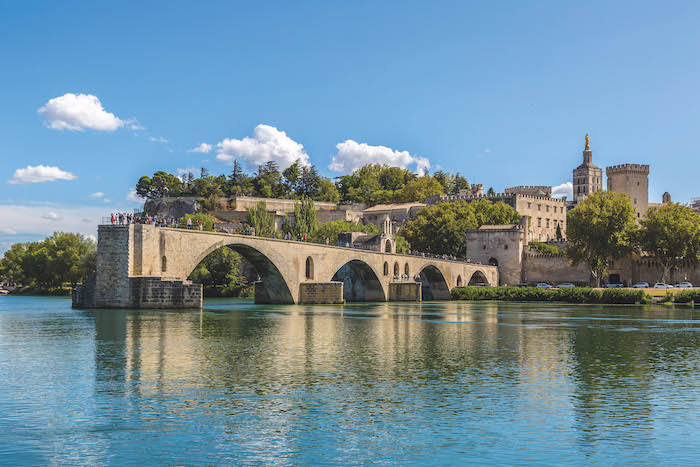
The world-famous Pont d’Avignon. Photo credit © Shutterstock
Avignon is also the gateway to the Vaucluse, a land of vivid contrasts and, to my mind, the beating heart of Provence. Stretching from the Rhône Valley in the west and the Luberon massif in the east, all the way north to the vertiginous Hautes-Alpes – a natural boundary between the Vaucluse and the wilder Drôme Provençal – this beautiful, bountiful land is a patchwork of orchards, olive groves and rolling vineyards interspersed with ragged mountains and impossibly picturesque villages perched on hilltops.
In spring – a glorious time to be here – almond, cherry and apricot blossoms flutter like snow in the Mistral gusts, and in early summer, fields are ablaze with electric blue lavender, dazzling sunflowers and scarlet poppies. In autumn, as the vineyards turn a mellow gold, the sun remains warm enough to lounge on café terraces in village squares well into November.
- The wine estates of Châteauneuf-du-Pape and Gigondas. Photo credit © Shutterstock
- The wine estates of Châteauneuf-du-Pape and Gigondas. Photo credit © Shutterstock
Village hopping is simple as the distances are short and the towns tiny enough to stroll in an hour or two. Taken in clusters, you can easily see a dozen in a long weekend, or perhaps follow the market days, which are staggered between villages.
Wine lovers will discover one of the most up-and-coming wine regions in France. Between the well-known southern Côtes du Rhône cru appellations of Gigondas, Beaumes-de-Venise, Vacqueyras and Châteauneuf-du-Pape, smaller vineyards in the Côtes du Luberon and Ventoux are making thrilling wines – many natural – that are ripe for discovery. More and more vineyards are welcoming visitors and the wine routes are well marked.
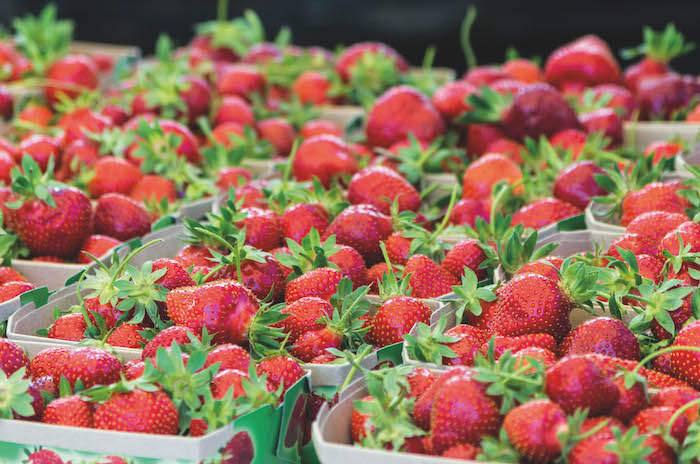
Fresh strawberries at the market. Photo credit © Shutterstock
For foodies, the Vaucluse Route des Saveurs indicates where to find the delicacies of the region, from fragrant Carpentras strawberries, Venasque cherries and Caromb black figs, to nougat, honey, cheeses and saffron. Markets in the bigger towns and villages – Apt and Carpentras on Saturday mornings and Vaison-La-Romaine on Tuesday mornings – offer a huge variety, but you’ll find smaller producers in the tiniest of villages.
A web of footpaths takes walkers through forests, around vineyards and farmland, up wooded mountains and down herb-strewn garrigue all ending with a well-earned repas. Great dining is everywhere. Look for the Bib Gourmand designation (with prix-fixe menus €32 and under, listed by town on the Michelin site) or follow the Michelin stars for a blow-out meal.
Those who want the whole deluxe wine, food and lodging experience in one luxurious package can park the car at a wine estate hotel and leave the rest to them. Although prices can be steep, they’re a fraction of what you’d pay in Paris and with everything at your fingertips: walking and cycling paths, wine tasting and cooking classes, gourmet dining, spa treatments and beautiful rooms and views.
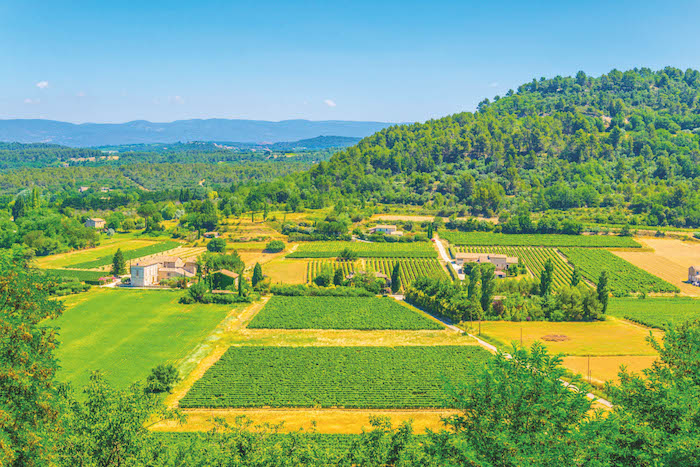
Ménerbes is a Plus Beau Village de France. Photo credit © Shutterstock
It Takes a Village
Culminating at a height of 1,125m, the Luberon Massif’s dramatic landscapes of sheer rock walls and canyons, forests, flower-strewn fields, and scrubby garrigue are beloved of hikers, climbers and birders (its cliffs shelter at least six endangered bird species, including several raptors and the tiny Ortolan bunting, a culinary delicacy hunted to near extinction by epicures). The rugged massif also harbours two strings of impossibly picturesque hilltop towns on its north and south sides, all within a few miles of each other.
On the north side of the range, start with the minuscule, once-abandoned hilltop town of Oppède-le-Vieux, whose gardens, 12th-century church and castle ruins were restored after the Second World War. A mile away, Plus Beau Village Ménerbes, where photographer Dora Maar spent the last decades of her life after her disastrous love affair with Picasso, exudes elegance. In summer, visitors can enjoy the views from her town house. Atop the village, at the Maison de la Truffe et du Vin du Luberon, you can sample and buy the local delicacies and vintages while taking in panoramic views from the summit garden.
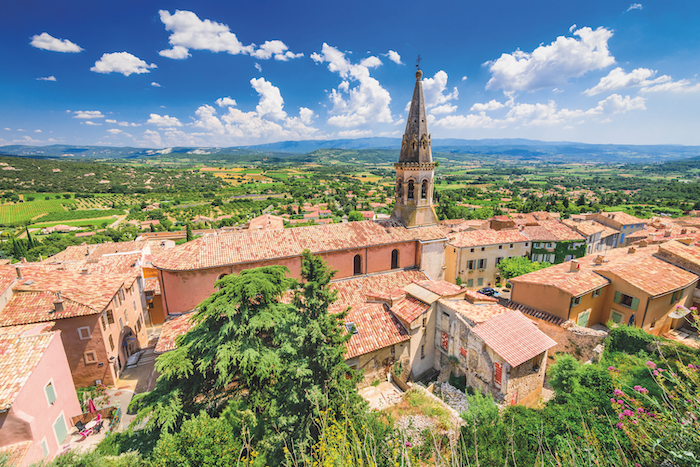
Marvel at the medieval beauty of Saint-Saturnin-lès-Apt. Photo credit © Shutterstock
Lacoste, still lorded over by the ruins of the Marquis de Sade’s family château, hosts a popular summer theatre festival founded by designer Pierre Cardin. A five-minute drive away, beautiful Bonnieux’s well-preserved ramparts, 12th-century towers and hilltop church afford lovely views. But for bird’s-eye vistas over practically the entire Luberon and beyond, head to the Forêt des Cèdres, a few minutes’ drive above the village.
The park’s 750 acres of 150-year-old Atlas cedars provide miles of footpaths and shade for a refreshing walk or picnic. For gastronomic dining, two-Michelin star chef Édouard Loubet’s eponymous restaurant, a major stop on the foodie circuit, offers a dream setting overlooking the Luberon massif.
With fewer than 100 residents, adorable Buoux is best known for the poetic remains of its 13th-century fort, while Saignon’s two well-preserved medieval churches, château ruins and pretty shaded squares make it the perfect stop for a quick lunch or coffee break, while taking in the views over Apt.
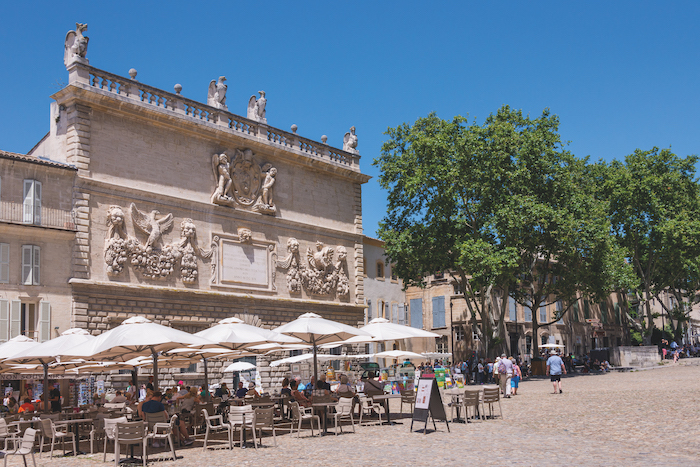
Be sure to allow at least a couple of days in Avignon, seat of the Popes in the 14th century. Photo credit © Shutterstock
Considered the modern capital of the Luberon, bustling Apt is actually one of the most ancient towns in the Vaucluse, founded by the Romans in 45 BC. Apt’s lively Saturday morning market is among the best in Provence. Go early for a parking spot around the town’s medieval walls and follow the winding streets lined with stalls showcasing local specialities, such as Apt candied fruit, a delicacy once reserved for the Avignon popes, which is made from the region’s abundant stone fruits.
Apt is also known for its distilleries for lavender and other essential oils of herbs and flowers. The town is also famous for its marbled faïence, a beautiful ceramic ware made from the richly coloured local clays, crafted here since the 18th century.
If a more intimate farmer’s market is to your taste, Saint-Saturnin-lès-Apt’s Tuesday morning affair gathers a number of local farmers, and the picturesque town has plenty to see, including two 17th-century windmills and panoramic views from the ancient château ruins.
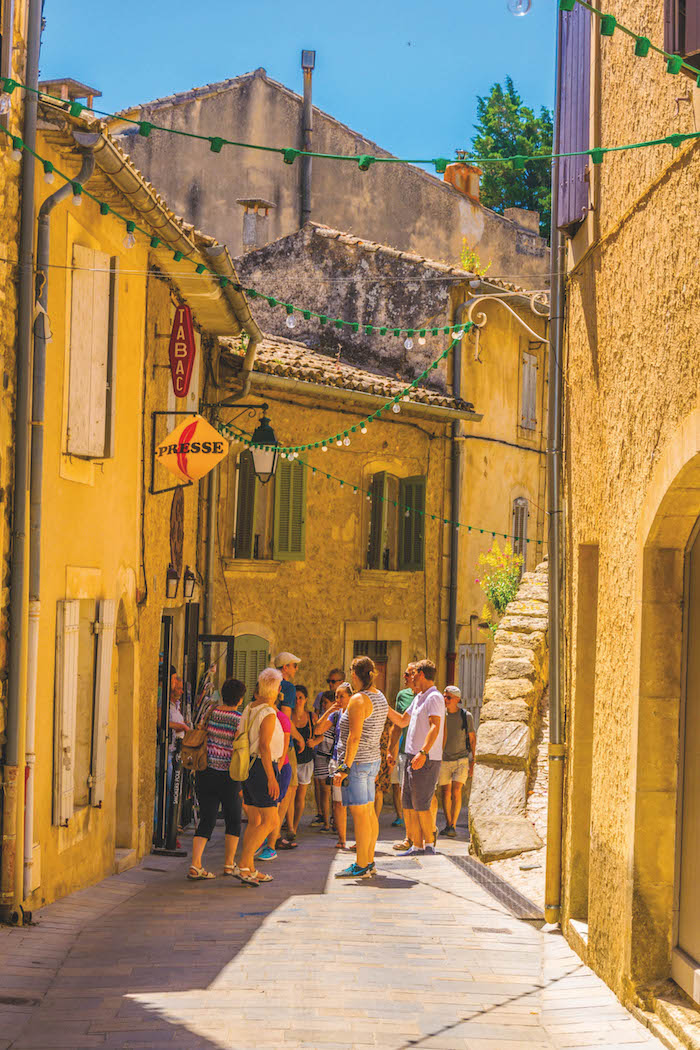
Wander around the intimate local market in pretty Ménerbes. Photo credit © Shutterstock
Eat, Stay, Love
A scenic 20-minute walk from quaint Saint-Saturnin, the hotel and wine estate Domaine des Andéols’ languid sprawl of manicured lawns, vineyards and olive groves reigned over by elegant cypresses couldn’t be more of a contrast. If so inclined, guests can toss their car keys in a chic armoire for the duration of their stay in an art-filled vacation home or sleek modern suite since everything they need – swimming, walking, cycling, top-notch dining, and most of all, privacy – can be found on the premises. The organic produce for the indoor-outdoor bistro – headed by Maurice Alexis, chef to two recent French presidents – is sourced from the domaine’s extensive gardens and vineyards. Meanwhile, the sophisticated gastronomic dining room is presided over by rising star Julien Bontus.
Another self-sufficient country idyll, La Bastide de Marie has earned a fiercely loyal clientele for its picturesque setting among 57 acres of working vineyards, its elegant Provençal farmhouse décor (original Picassos included) and a table so exceptional that the local gastronomes depend on it. If you can tear yourself away, it’s a great base from which to explore the villages in the area and it’s within easy walking or cycling distance of Ménerbes.
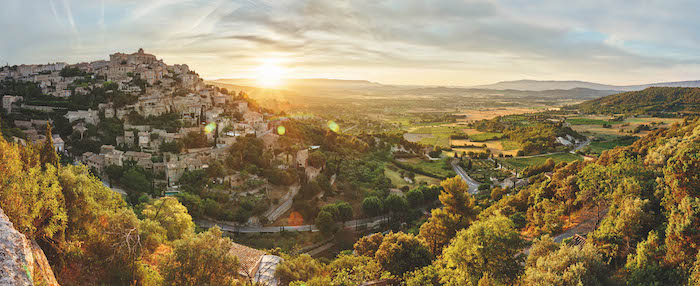
The Luberon Valley. Photo credit © Shutterstock
The Domaine de Fontenille, near Lauris, is also an ideal base for exploring the chain of villages along the southern side of the Luberon: Lauris, Lourmarin, Cadenet, Ansouis and Cucuron. Fontenille ticks all the boxes of the quintessential Provençal country estate: ancient cedars and plane trees towering over wide outdoor terraces, a rambling lawn, rose gardens, a gurgling fountain and a picturesque grotto, all among acres of vineyards. Its stylish décor is the work of two Parisian art dealers with a love of contemporary photography. Award-winning wines and Michelin-starred dining cap a sophisticated all-around experience that includes a lovely lawn-side pool and spa treatments on demand. Wine lovers can tour the winery and sample the vintages in a streamlined tasting room.
At Auberge La Fenière, near Lourmarin, a more modest country atmosphere prevails – except in the dining room, where Michelin-starred chef Nadia Sammut raises non-dairy, non-gluten gastronomy to an art. You wouldn’t know it from her exquisite dishes, but those for whom it matters can eat without a care in the world. Although Sammut is highly sought-after around the world to teach about sustainable agriculture and non-gluten and non-dairy cuisine, you will never eat a meal at La Fenière that’s not cooked by the chef herself.
Antiques still take front and centre in L’Isle-sur-la-Sorgue, but aside from its 350 antiques stores, ‘the Venice of Provence’ offers consistently excellent art exhibitions at the Campredon Arts Centre and the Fondation Villa Datris.
Since 1808, the Sorgue River has aided Brun de Vian-Tiran’s production of some of the finest woollens in France. At the chic new Filaventure (adventures in thread) visitors are taken through the fascinating process of making the company’s luxe products in cashmere, alpaca, mohair and more, while the boutique stocks its gorgeous bedding, throws and scarves. Afterwards, head over to Pâtisserie Jouvaud for a head-spinning array of fine pastries, chocolates and speciality sweets, including preserved local apricots and strawberries. If a glass of local wine is more to your taste, 17 Place aux Vins is delightful indoors and out.
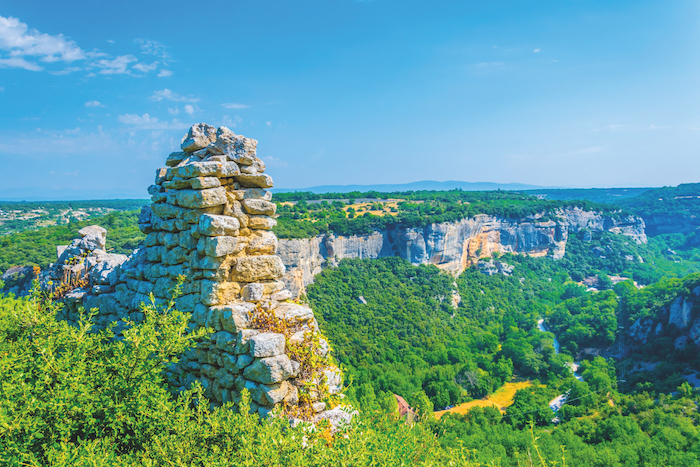
Ruins at Buoux castle. Photo credit © Shutterstock
Ancient History
From the L’Isle-sur-la-Sorgue, don’t overlook the cluster of tiny villages, perched and otherwise, within a five-mile radius. Charming Venasque has an outstanding church and baptistery dating to Roman times; Saint-Didier has a lively Monday morning market and artisanal nougat, a local specialty; and Pernes-Les-Fontaines, which boasts no fewer than 40 fountains. If you’re looking for a luxury hotel in the area, the ambiance and hospitality at the boutique five-room Château la Roque, in La Roque-sur-Perne is hard to beat.
Ancient sites to visit in the Vaucluse extend as far back as Palaeolithic times. Among them are L’Abri du Pont de la Combette in Bonnieux, where traces of Neanderthal occupation have been found dating back 60,000 years, and Baume des Peyrards in Buoux, which started as a hunting stop before becoming a permanent habitat in the Middle Paleolithic period.
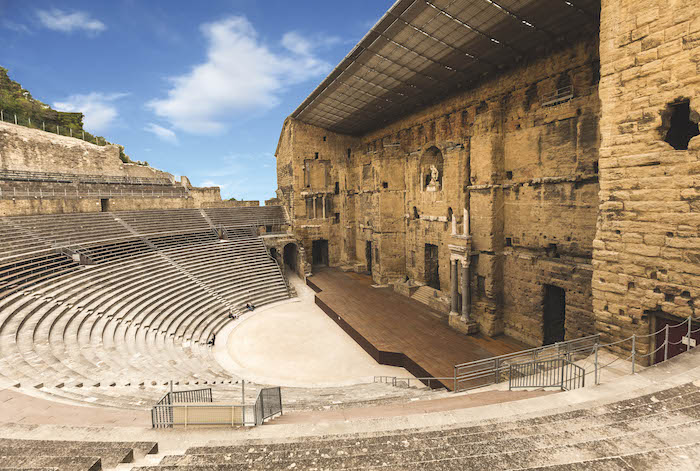
The Roman amphitheatre at Orange. Photo credit © Shutterstock
But the area is best known for its extraordinary Roman ruins. The UNESCO-listed Théâtre Antique d’Orange, one of the world’s best preserved Roman theatres in the ancient Roman town of Orange, is a must. Depending on when you go, you may be lucky enough to catch a reenactment. The sprawling town of Vaison-la-Romaine spans 2,000 years of history, with remains of its Gallo-Roman town walls, baths, elegant homes and theatre, and the beautiful Roman bridge leading to the old town.
Beginning or ending your journey in Avignon is a must; whether you stay for a long weekend – which we recommend – or just a day, there’s much to explore here. Tucked inside Avignon’s beautifully preserved ramparts, the old town is a delight to roam and discover. Besides the Palais des Papes, home of the French popes for most of the 14th century, Avignon is an arts capital par excellence, with a dozen superb museums and arts centres to explore, including the world-class Collection Lambert (and its fabulous terrace restaurant) and the Musée Calvet, housed in the magnificent Hôtel de Villeneuve-Martignan.
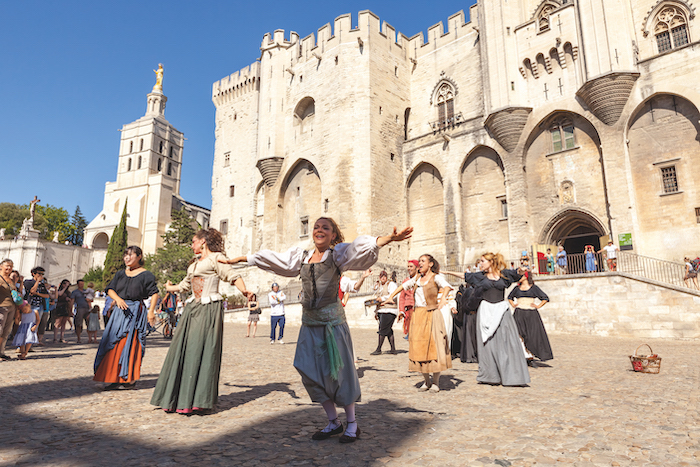
Avignon. Photo credit © Shutterstock
Avignon is also a centre for excellent food, wine and lodging, with two of the Vaucluse’s best hotels, elegant La Mirande, a mansion hotel two steps from the Palais des Papes, and the exquisite four-room La Divine Comédie, set in an acre of lush gardens, Avignon’s largest private garden.
In July, the Festival d’Avignon and the Festival Off draw theatre buffs from around the world for their diverse programmes of 1,000 performances per day. Oenophiles can enjoy wine classes at l’École des Vins d’Inter-Rhône, which can be tailored specifically for you, with teachers from L’Université du Vin in Suze-la-Rousse. And over at the Marché des Halles, which is open every day but Monday, you can find all of the bounty of Provence in a single eye-popping market.
Smart phones are great but don’t forego the local tourist office, where you can find helpful, English-speaking staff and brochures in English in even the smallest towns. When in Avignon, avail yourself of the excellent tourist centre, just a three-minute walk from the Collection Lambert. Wine enthusiasts will get the best up-to-date information on visiting vineyards, tastings and events at Inter Rhône, housed in an 18th-century mansion in one of the loveliest sections of the old city. Now that’s well worth raising a glass to.
From France Today magazine
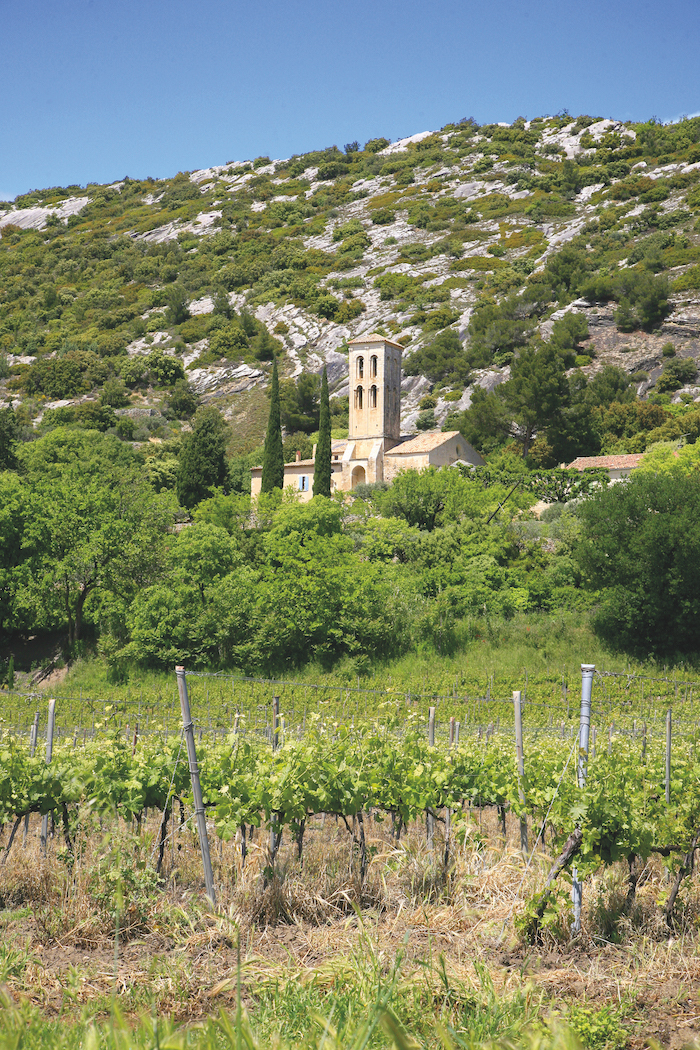
Notre-Dame d’Aubune in Beaumes-de-Venise. Photo credit © Shutterstock
Share to: Facebook Twitter LinkedIn Email
Leave a reply
Your email address will not be published. Required fields are marked *

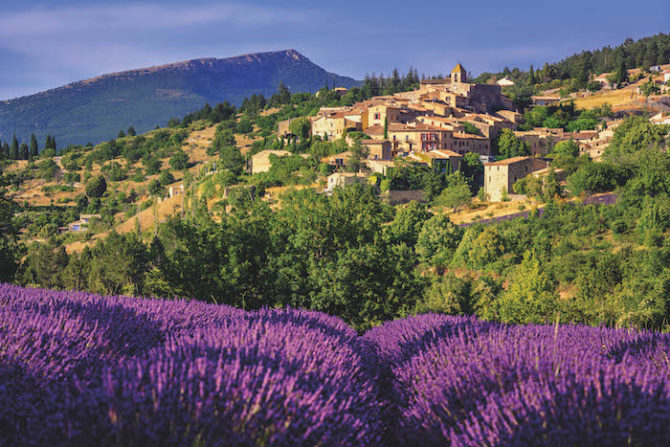

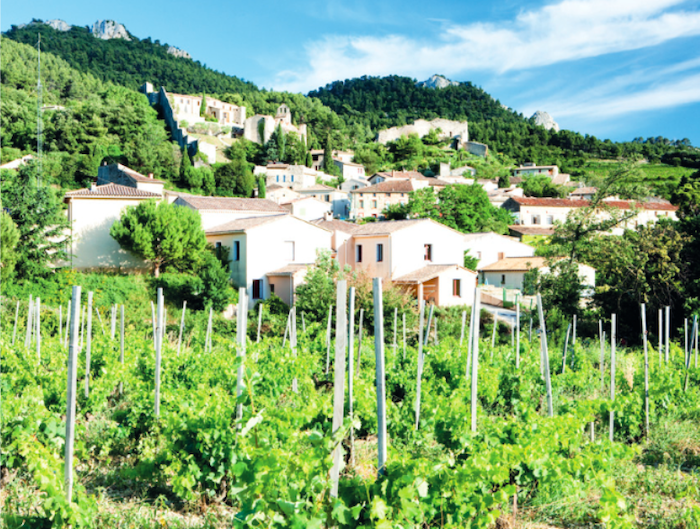
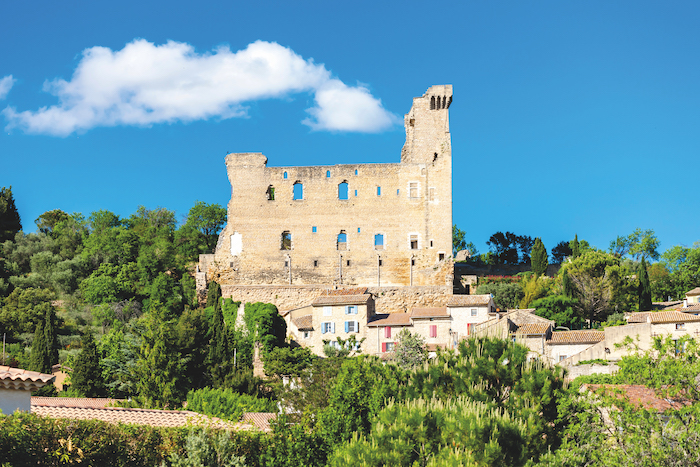



REPLY
REPLY
REPLY
REPLY
REPLY
REPLY
REPLY
REPLY